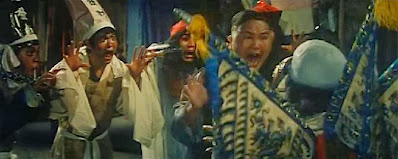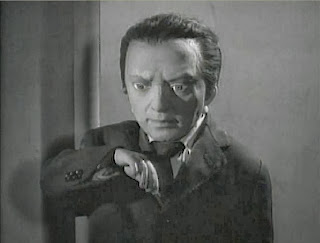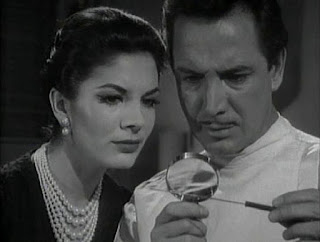... aka: Hocus Pocus
... aka: Hogus Pogus
... aka: Yan hak gwai
Directed by:
Yuet Sang Chin
... aka: Hogus Pogus
... aka: Yan hak gwai
Directed by:
Yuet Sang Chin
Ghost comedies were all the rage in
Hong Kong during the 80s... and here's yet another one from Golden Harvest.
Things begin with an elaborately-staged theater production full of lavish
costumes and stunts being put on by a traveling Chinese opera company. The
leader Uncle Sheng is played by Ching-Ying Lam, the one-eyebrow
priest from the later hit Mr. Vampire films. Though his profession in
this one is different, he's already sporting a major facial imperfection
(this time a hairy mole on his chin) and playing straight comic foil to a
bunch of mugging costars during various supernatural gags. Lam's character
is in charge of a bunch of immature young actors who are constantly
pulling pranks on one another, which in the earlier scenes makes this seem
like the Asian equivalent of an American summer camp movie. Kuei (Wei
Tung) is
usually the ringleader behind it. He easily swindles money and the best
bed from the dumb Piao (Peter Chan) and pretends to be an angry ghost to trick another
guy into eating mud that he'd just pissed all over. Kuei and the others stage a
full-scale haunting to scare the shit out of smirky, arrogant star
attraction Chia (Ho Kai Law). Maybe it'll teach everyone a lesson not to take all this
stuff so lightly if a real haunting were to occur... and that's just what
happens.
Deep in the netherworld, a mistreated, mischievous 300-year-old ghost with a blue bulbous head escapes into our world.
Now let me stop here for a second and note that I couldn't tell whether this spirit was intended to be a male or a female. Though played by the male director, it
behaves like a woman and even appears to have been dubbed over by a female
voice. Whatever gender, it giggles and
mugs for the camera constantly and quickly grates on the nerves tripping
people, knocking things over and doing other obnoxious, destruction
things. Not technically a ghost, it's actually a poltergeist and gets in
the middle of a choreographed fight to ruin a performance and then
decides to wreck havoc in Chia's room and destroy all of his wardrobe. So
basically, the poltergeist stirs up shit, someone else becomes the scapegoat and the guys, blaming each other, get into long fights to make sure the martial arts
quotient is met. Chia is eventually possessed by the spirit, threatens to kill
everyone, threatens to kill himself, beats his head against a wall and
then is rescued when they fetch a baby to piss on his head (!)
Realizing their troupe is now cursed by a destructive ghost, Uncle Sheng
decides to kill two birds with one stone by working an exorcism into a
stage show. They call forth the poltergeist and learn that in her human
existence she was murdered and is now a wandering spirit who'll continue
to live between our world and the next until her bones are properly
buried. They find her remains underneath the stage, bury them in a nice
location and then put her soul to rest. The end? Nope, there's still
fifteen minutes to spare so this goes off on an entirely different (and
suddenly serious) direction when a malicious, long-haired demon shows up to
spoil the opera company's lavish celebratory feast. Lasers shoot out of
nowhere and fry a guy, tables split in half, stuff explodes, chairs and
people start flying around the room, cooked fish come to life, ghost POV
shots weave over and under tables and a portal opens up on the wall and
starts sucking stuff inside. Things end with an elaborate battle between
our heroes and the flying, super-strong demon after they trap it inside a
large room with blood-covered floors and blood-soaked nets. Whoa, where
the hell did all that come from?
Though I thoroughly enjoyed the last 15 minutes (the action and fight
choreography are great), it's tough to really
recommend this one because of the slow and highly uneven start and the
abrupt last minute change in tone. You also may think you're losing your
mind during a sequence where the female cook has her finger bitten off by
a turtle that pops out of a pot of soup and then gets tossed around a room
by an invisible force while the famous Goblin score from Suspiria (1977)
erupts on the soundtrack. Not content with just swiping the music from
just one source, this also buffers its entire score with stolen and, in
some cases very famous, music from Night of the Living Dead (1968),
Carrie (1976), The Amityville Horror (1979), The Shining (1980) and even
Tourist Trap (1979). I guess if nothing else, they at least they have
great taste in horror film scores.
Filmed in 1983, Hocus Pocus (called "Hogus Pogus" on the DVD cover)
was a money-maker in Asia for producer Sammo Hung and his production company, though they'd have much bigger hits than this. It has never been released in the U.S. (possibly because the entire music score would have to be replaced).
★★










































